In the fourth and final part of our double moving average market timing model backtests, we consider Sensex and other Indian Indices. We have already established that the model reasonably works (see links below) with Indian gilts, Nasdaq 100, the S&P 500 and gold. Our primary goal in this updated study is to illustrate market-specific risks and the sequence of returns risk with market timing.
Previous episodes in this series:
- Is it possible to time entry and exit from gilt mutual funds for better returns?
- Testing a double moving average market timing model (part 1): Nasdaq 100
- Testing a double moving average market timing model with S&P 500 (Part 2)
- Testing a double moving average market timing model with gold (Part 3)
We shall use Sensex price data from April 1979 and either a fixed return debt instrument offering 6% a year or I-bex gilt index.
Systematic investing: A sum is invested each month in equity and debt. We shall consider 50% equity and 50% debt over 5 years, 10 years and 15 years. The portfolio is rebalanced annually. Taxes and exit loads due to this are not considered.
Tactical investing: If the six -months moving average (6MMA) of the S&P 500 is greater than the 12-month moving average (12MMA) then all debt holdings are sold and invested in equity. All future investments are also made in equity.
Join 32,000+ readers and get free money management solutions delivered to your inbox! Subscribe to get posts via email! (Link takes you to our email sign-up form)
🔥Want to create a complete financial plan? Learn goal-based investing? Exclusive access to our DIY tools? Increase your income with your skills? Use this link to enjoy massive discounts on our robo-advisory tool & courses! 🔥
If 6MMA < 12 MMA, then all equity holdings are sold and invested in debt. All future investments are also made in debt. Tax and exit load due to the switches are not considered. However, typically the average number of switches is lesser than annual rebalancing. For example, the no of buy/sell switches over 5 years is only about twice on average; is about 4 on average over 10 years; and about 5 on average over 15 years.
This is one such run over the last 15-years.
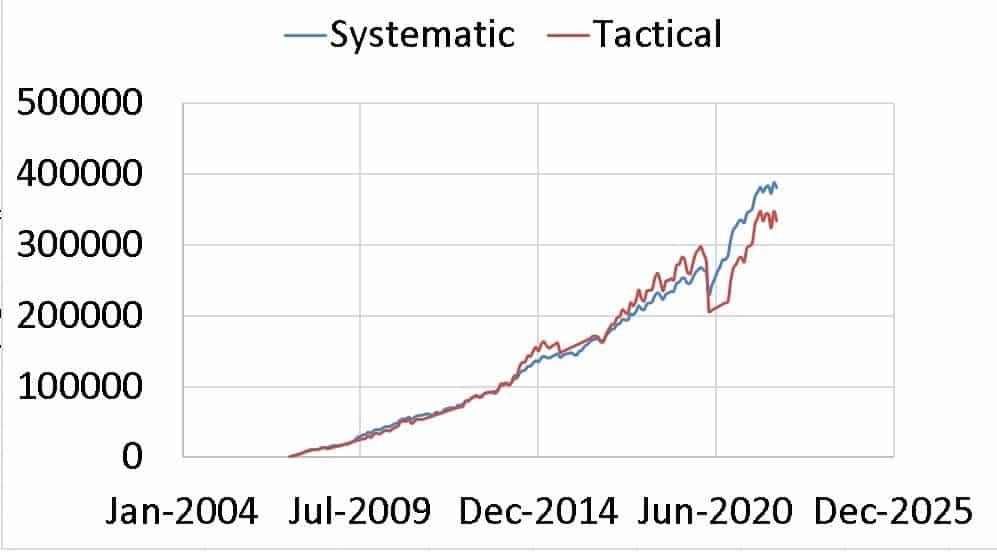
Notice that the tactical strategy fails badly. The reason for this becomes clear if we look at the moving averages.
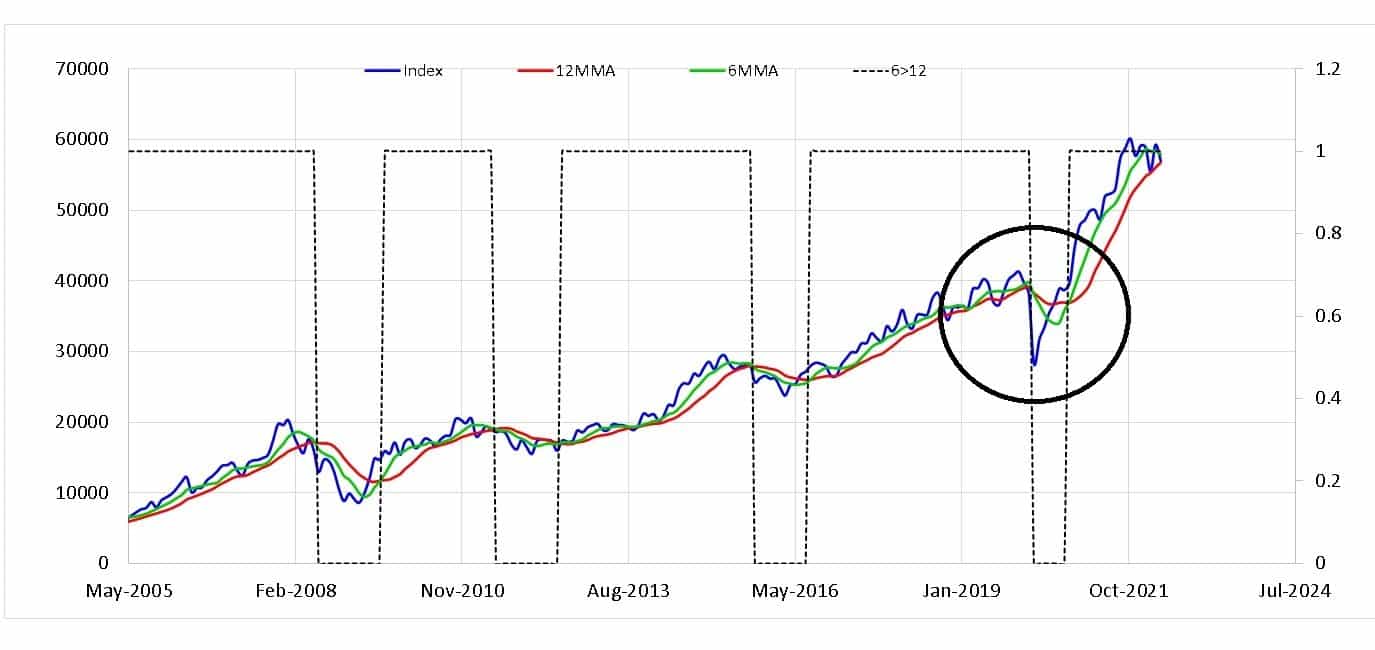
The March 2020 crash was short-lived (compared to the 2008 crash) but it was quite sharp. See: Sensex loses 30% twice as fast as 2008 crash! The price has never moved above or below both moving averages as it did during March 2020.
Because of this a longer time was spent holding cash and chunk of the recovery accessible to the systematic investor could not be enjoyed by the tactical investor.
Similar trends are also seen with Nifty Next 50.
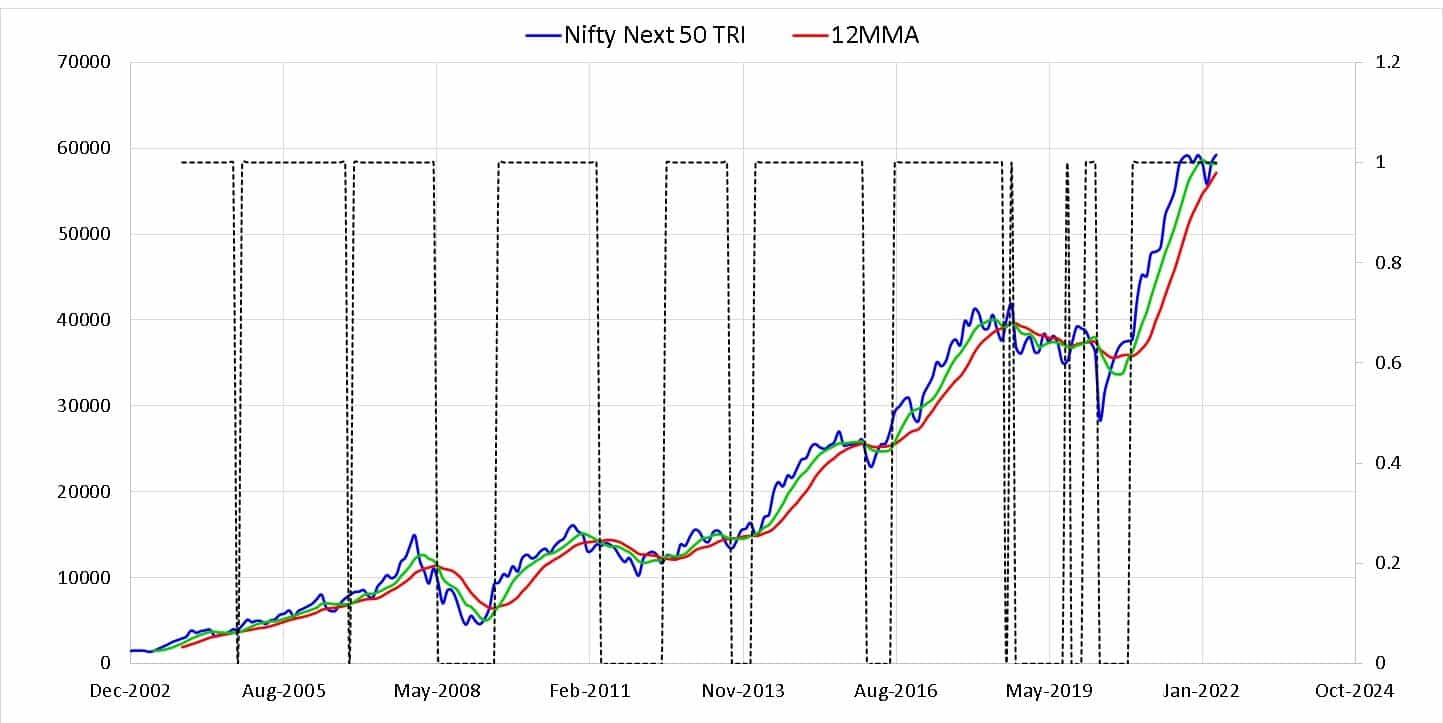
With Nifty Midcap 150.
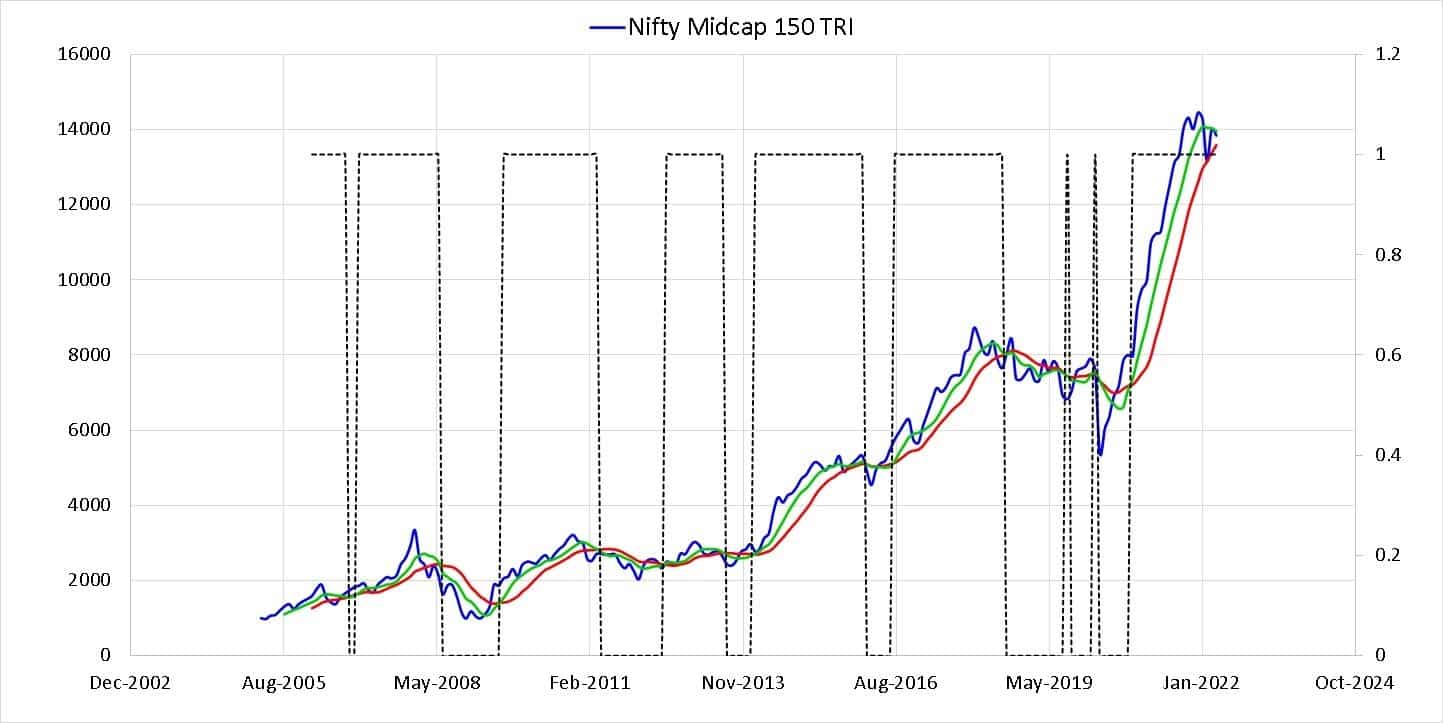
And Nifty SMallcap 250 (although relatively lesser).
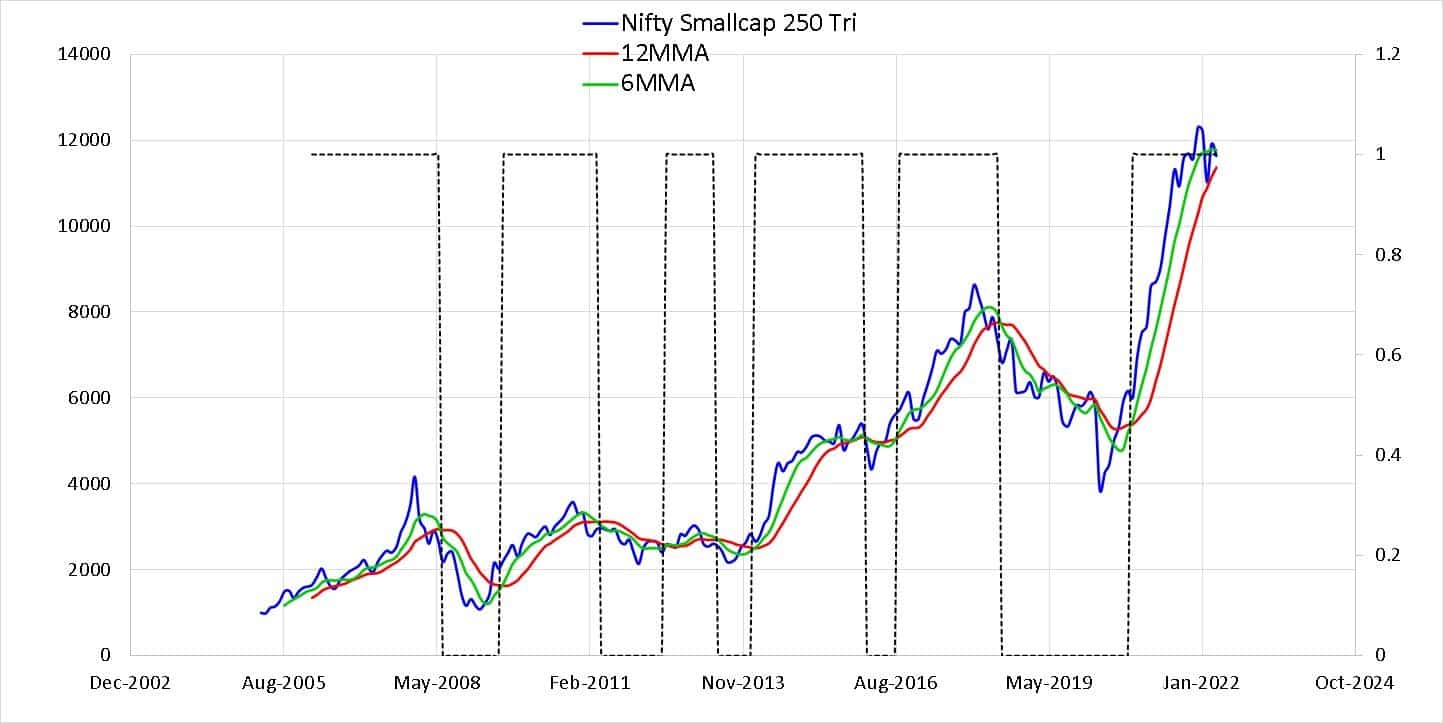
However, this is not seen in the S&P 500 (or the Nasdaq 100 TRI, not shown).
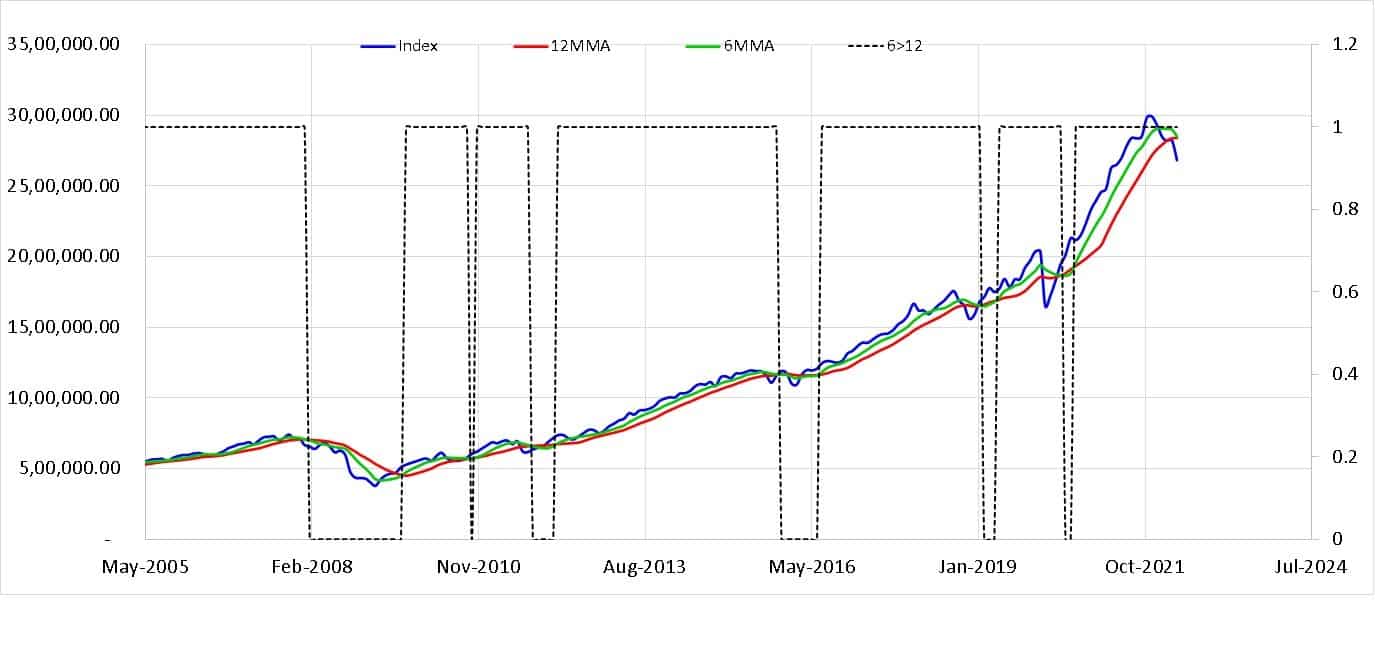
This has important consequences. If you look at the data over 15 years published for the S&P 500 or the Nasdaq 100, the tactical strategy does not fail spectacularly anywhere.
S&P 500: In fact, the tactical strategy continues to hold sway through the March 2020 crash and beyond.
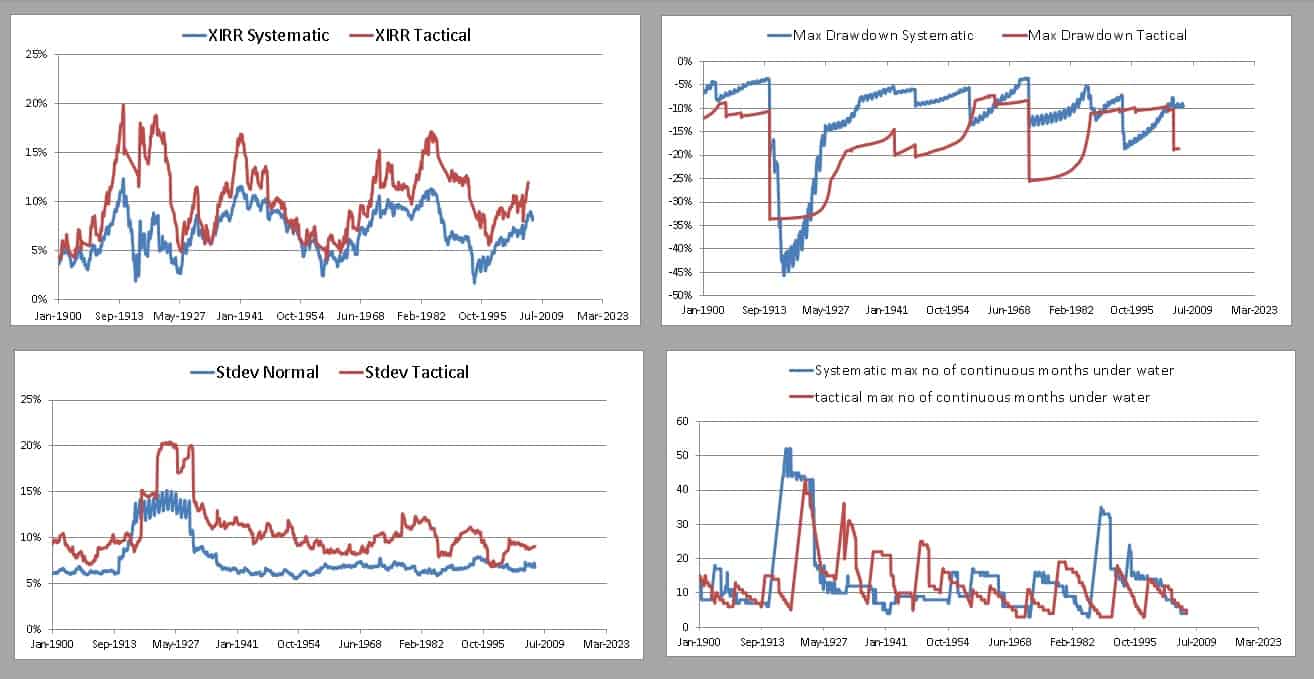
Sensex: The dramatic underperformance after the march 2020 crash can be clearly seen in the left image of the top panel.
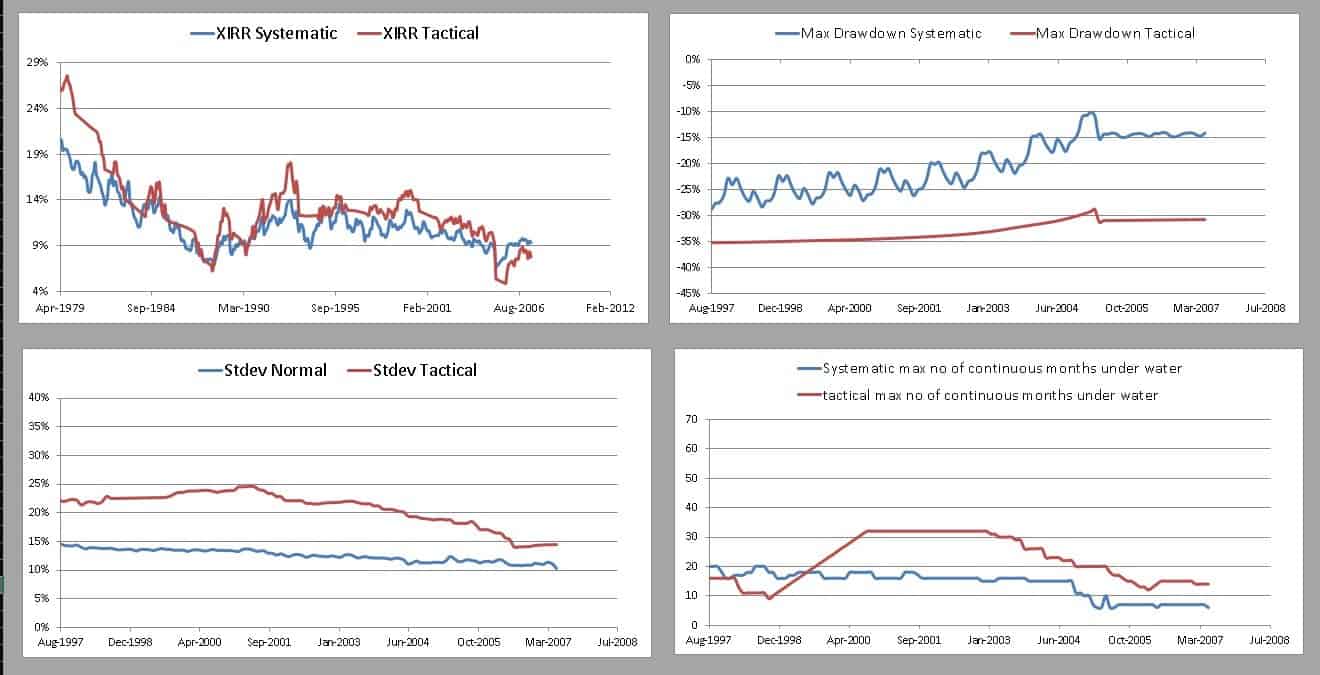
The 20-year data does not look as bad but that is cold comfort.
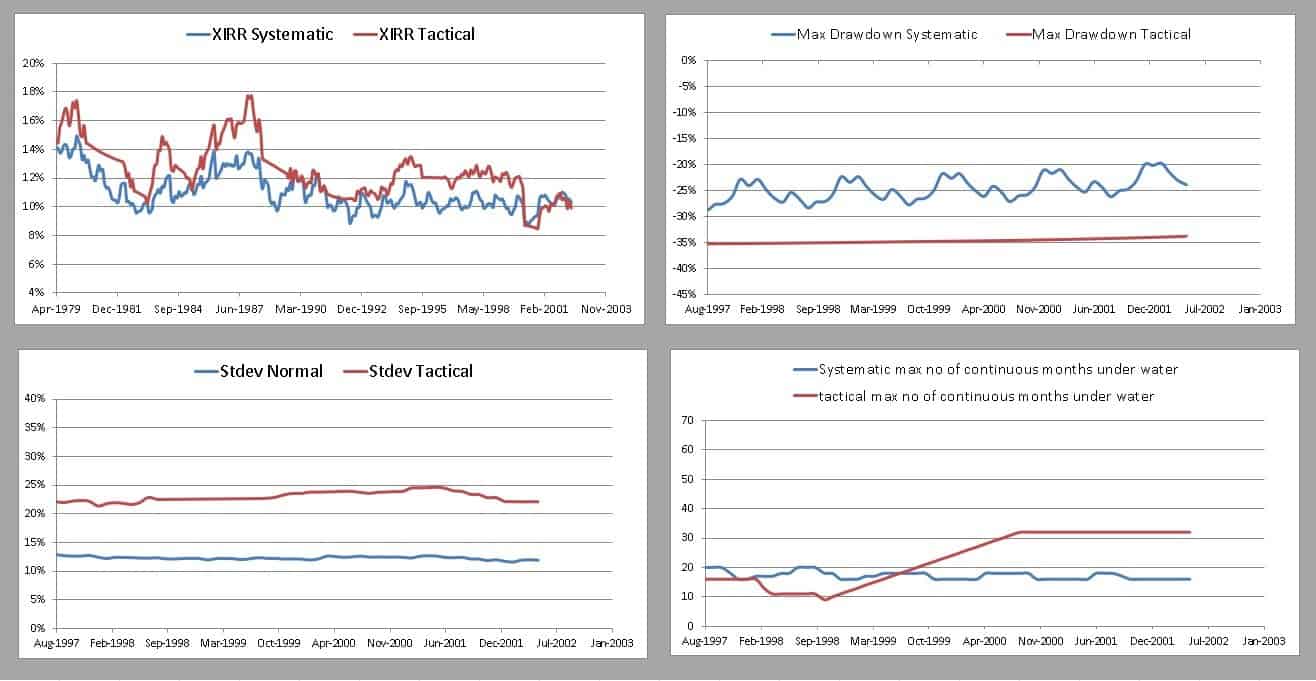
So what is the takeaway here? We already knew it will not work all the time. A particular sequence of returns involving a market crash and a sudden price deviation has made it clear that the double moving average tactical strategy can fail spectacularly.
This particular sequence of return was not observed over 122 years of the S&P 500 data! This is why it is important to appreciate the limitations of backtesting tactical (or systematic) strategies.
What works for one asset allocation may not work for others (as we showed for 70% equity compared to 50% equity). What works for one market need not work for all others. What worked in the past need not work in future as we have no idea how the future sequence of returns will pan out.
It must be understood that sequence of returns is common to both systematic and tactical strategies. When they tell us “past performance is not indicative of future performance”, they mean it! And they have precisely sequence of returns in mind. Also see: Want to be financially free? Do not count on frugality! Worry about sequence of returns risk!
Note: The method fails across March 2020 for Sensex (which is similar to Nifty 50), Nifty Next 50 and Nidty Midcap 150 but does not fail for Nifty Small cap 250! See grapshs in the appendix below. Again that reiterates that the method is not special and can arbitrarily win or lose.
It is this arbitrary nature of the method that investors should be wary about. Those who believe in this mehod or their like should be ready to play it by ear and counter large deviations in real time. This is easier said than done.
Does this mean the double moving average strategy has failed? We have shown that it can fail bigger than ever seen before. From analysts point of view, I dont think it can be called a failure. Just that it has fallen in line with nothing works all the time in all markets.
From an investors’ point of view, any strategy is a gamble including a SIP. For example, a SIP in a small cap fund over the long term has the highest uncertainty. See Why a SIP in Small Cap Mutual Funds is a waste of money and time.
This particular tractical strategy comes with higher risks and that may or may not pay off. It can be used by those who do not mind taking the risk. Just that they need to be wary of the price deviating too much from the averages. Most investors’ choose one strategy, tell themselves that that have chosen the best path and never bother to compare for they are afriad of what they might see!
Does this mean systematic investing is the best? No. It is just another method sometimes superior to other methods and sometimes inferior. We will never know when we start investing. It is a leap of faith.
That’s it for this series! Thank you for your patience. Additional results are presented in the appendix below.
Appendix
Sensex 15 year and 70% equity.
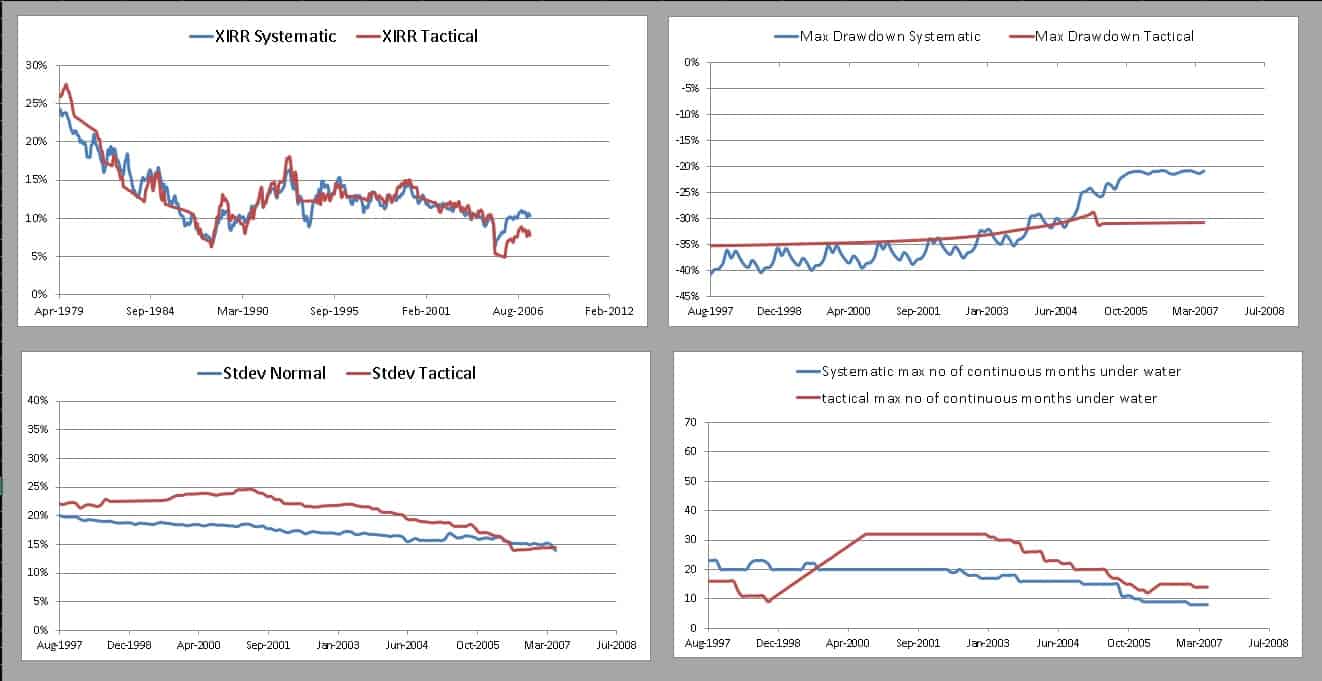
Sensex 10 years; 50% equity
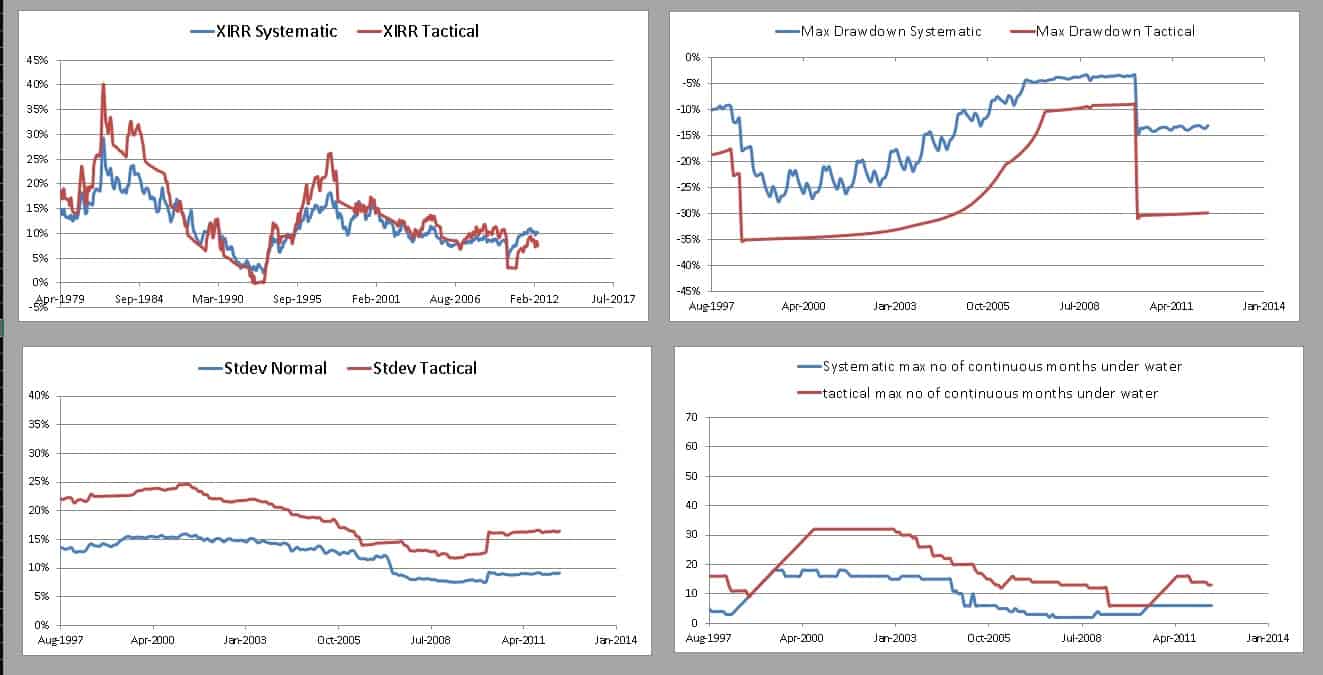
Nifty Next 50; 15 years; 50% equity
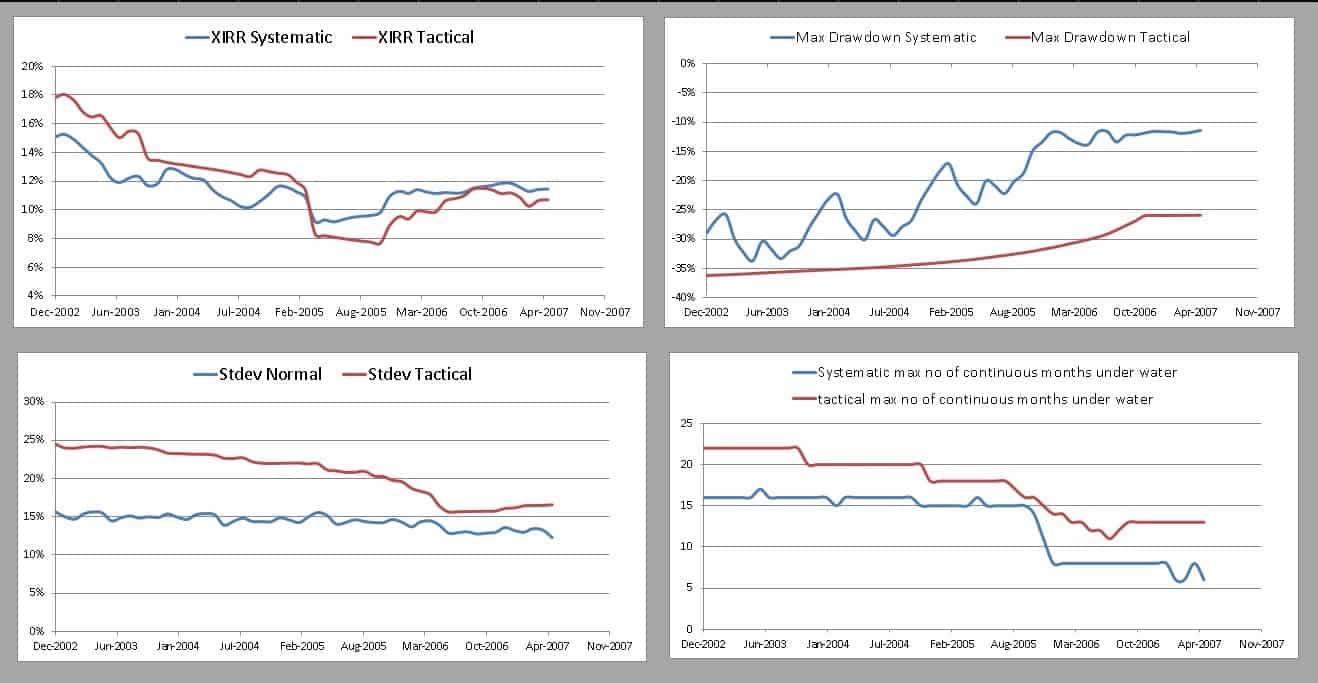
Nifty Midcap 150; 10 years; 50% equity

Nifty Smallcap 250 TRI; 10 years; 50% equity
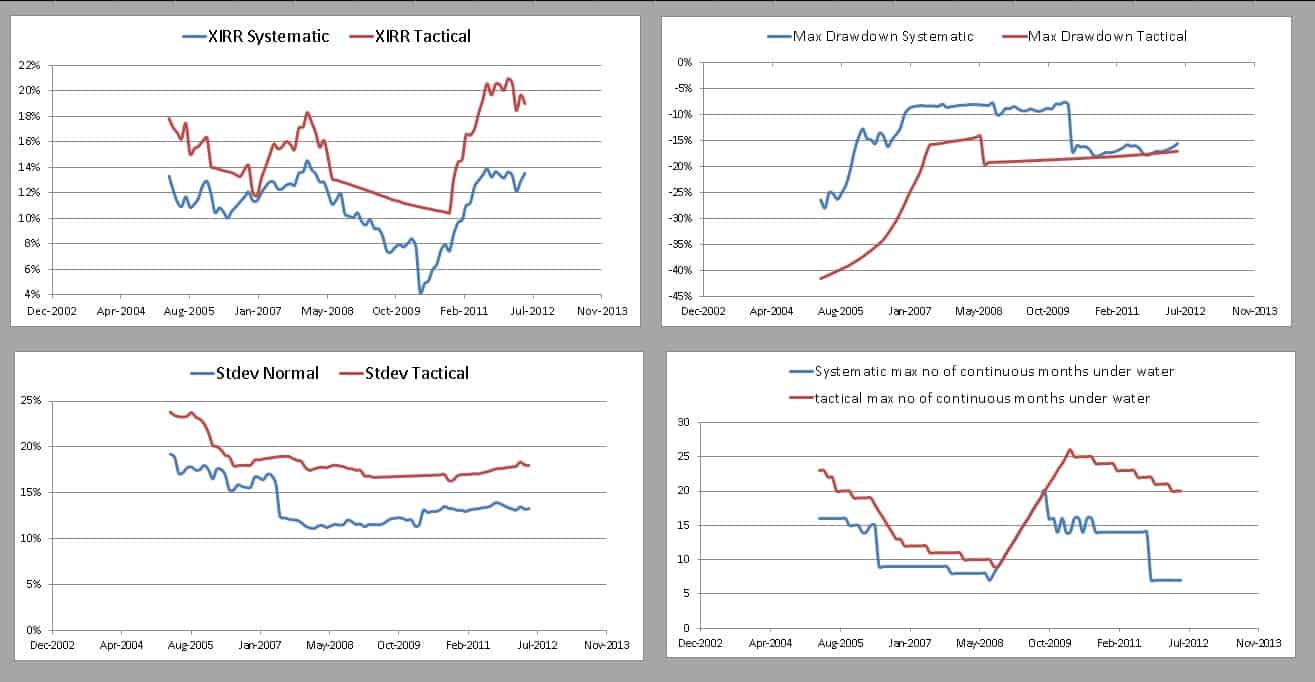
Nifty Smallcap 250 TRI; 5 years; 50% equity
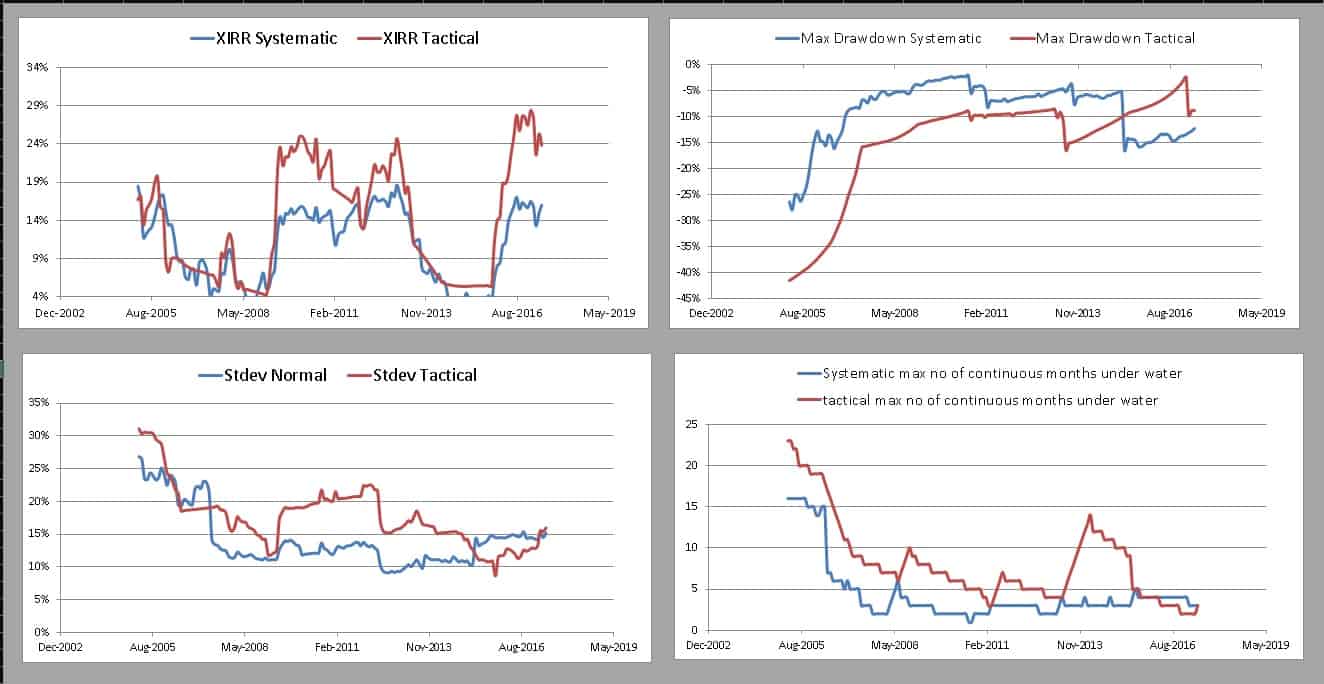

Use our Robo-advisory Tool to create a complete financial plan! ⇐More than 3,000 investors and advisors use this! Use the discount code: robo25 for a 20% discount. Plan your retirement (early, normal, before, and after), as well as non-recurring financial goals (such as child education) and recurring financial goals (like holidays and appliance purchases). The tool would help anyone aged 18 to 80 plan for their retirement, as well as six other non-recurring financial goals and four recurring financial goals, with a detailed cash flow summary.
🔥You can also avail massive discounts on our courses and the freefincal investor circle! 🔥& join our community of 8000+ users!
Track your mutual funds and stock investments with this Google Sheet!
We also publish monthly equity mutual funds, debt and hybrid mutual funds, index funds, and ETF screeners, as well as momentum and low-volatility stock screeners.
You can follow our articles on Google News

We have over 1,000 videos on YouTube!

Join our WhatsApp Channel



- Do you have a comment about the above article? Reach out to us on Twitter: @freefincal or @pattufreefincal
- Have a question? Subscribe to our newsletter using the form below.
- Hit 'reply' to any email from us! We do not offer personalised investment advice. We can write a detailed article without mentioning your name if you have a generic question.
Join 32,000+ readers and get free money management solutions delivered to your inbox! Subscribe to get posts via email! (Link takes you to our email sign-up form)
About The Author
 Dr M. Pattabiraman (PhD) is the founder, managing editor and primary author of freefincal. He is an associate professor at the Indian Institute of Technology, Madras. He has over 13 years of experience publishing news analysis, research and financial product development. Connect with him via Twitter(X), LinkedIn, or YouTube. Pattabiraman has co-authored three print books: (1) You can be rich too with goal-based investing (CNBC TV18) for DIY investors. (2) Gamechanger for young earners. (3) Chinchu Gets a Superpower! for kids. He has also written seven other free e-books on various money management topics. He is a patron and co-founder of “Fee-only India,” an organisation promoting unbiased, commission-free, AUM-independent investment advice.
Dr M. Pattabiraman (PhD) is the founder, managing editor and primary author of freefincal. He is an associate professor at the Indian Institute of Technology, Madras. He has over 13 years of experience publishing news analysis, research and financial product development. Connect with him via Twitter(X), LinkedIn, or YouTube. Pattabiraman has co-authored three print books: (1) You can be rich too with goal-based investing (CNBC TV18) for DIY investors. (2) Gamechanger for young earners. (3) Chinchu Gets a Superpower! for kids. He has also written seven other free e-books on various money management topics. He is a patron and co-founder of “Fee-only India,” an organisation promoting unbiased, commission-free, AUM-independent investment advice.Our flagship course! Learn to manage your portfolio like a pro to achieve your goals regardless of market conditions! ⇐ More than 3,500 investors and advisors are part of our exclusive community! Get clarity on how to plan for your goals and achieve the necessary corpus no matter the market condition!! Watch the first lecture for free! One-time payment! No recurring fees! Life-long access to videos! Reduce fear, uncertainty and doubt while investing! Learn how to plan for your goals before and after retirement with confidence.
Increase your income by getting people to pay for your skills! ⇐ More than 800 salaried employees, entrepreneurs and financial advisors are part of our exclusive community! Learn how to get people to pay for your skills! Whether you are a professional or small business owner seeking more clients through online visibility, or a salaried individual looking for a side income or passive income, we will show you how to achieve this by showcasing your skills and building a community that trusts and pays you. (watch 1st lecture for free). One-time payment! No recurring fees! Life-long access to videos!
Our book for kids: “Chinchu Gets a Superpower!” is now available!


Must-read book even for adults! This is something that every parent should teach their kids right from their young age. The importance of money management and decision making based on their wants and needs. Very nicely written in simple terms. - Arun.Buy the book: Chinchu gets a superpower for your child!
How to profit from content writing: Our new ebook is for those interested in getting a side income via content writing. It is available at a 50% discount for Rs. 500 only!
Do you want to check if the market is overvalued or undervalued? Use our market valuation tool (it will work with any index!), or get the Tactical Buy/Sell timing tool!
We publish monthly mutual fund screeners and momentum, low-volatility stock screeners.
About freefincal & its content policy. Freefincal is a News Media organisation dedicated to providing original analysis, reports, reviews and insights on mutual funds, stocks, investing, retirement and personal finance developments. We do so without conflict of interest and bias. Follow us on Google News. Freefincal serves more than three million readers a year (5 million page views) with articles based only on factual information and detailed analysis by its authors. All statements made will be verified with credible and knowledgeable sources before publication. Freefincal does not publish paid articles, promotions, PR, satire or opinions without data. All opinions will be inferences backed by verifiable, reproducible evidence/data. Contact Information: To get in touch, please use our contact form. (Sponsored posts or paid collaborations will not be entertained.)
Connect with us on social media
- Twitter @freefincal
- Subscribe to our YouTube Videos
- Posts feed via Feedburner.
Our publications
You Can Be Rich Too with Goal-Based Investing
 Published by CNBC TV18, this book is designed to help you ask the right questions and find the correct answers. Additionally, it comes with nine online calculators, allowing you to create custom solutions tailored to your lifestyle. Get it now.
Published by CNBC TV18, this book is designed to help you ask the right questions and find the correct answers. Additionally, it comes with nine online calculators, allowing you to create custom solutions tailored to your lifestyle. Get it now.Gamechanger: Forget Startups, Join Corporate & Still Live the Rich Life You Want
 This book is designed for young earners to get their basics right from the start! It will also help you travel to exotic places at a low cost! Get it or gift it to a young earner.
This book is designed for young earners to get their basics right from the start! It will also help you travel to exotic places at a low cost! Get it or gift it to a young earner.Your Ultimate Guide to Travel
 This is an in-depth exploration of vacation planning, including finding affordable flights, budget accommodations, and practical travel tips. It also examines the benefits of travelling slowly, both financially and psychologically, with links to relevant web pages and guidance at every step. Get the PDF for Rs 300 (instant download)
This is an in-depth exploration of vacation planning, including finding affordable flights, budget accommodations, and practical travel tips. It also examines the benefits of travelling slowly, both financially and psychologically, with links to relevant web pages and guidance at every step. Get the PDF for Rs 300 (instant download)